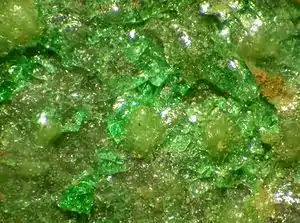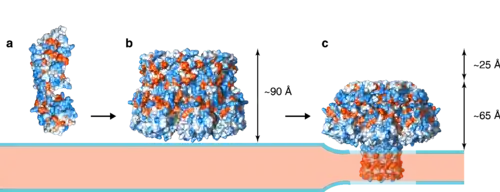WikiJournal of Science
Open access • Publication charge free • Public peer review • Wikipedia-integrated
|
VOLUME 2 (2019)
ISSUE 1
Previous issue
Authors: Collin Knopp-Schwyn, et al. , et al.
Widgiemoolthalite is a rare hydrated nickel(II) carbonate mineral with the chemical formula (Ni,Mg)5(CO3)4(OH)2·5H2O. Usually bluish-green in color, it is a brittle mineral formed during the weathering of nickel sulfide. Present on gaspéite surfaces, widgiemoolthalite has a Mohs scale hardness of 3.5 and an unknown though likely disordered crystal structure. Widgiemoolthalite was first discovered in 1992 in Widgiemooltha, Western Australia, which was its only known source as of 2016. It was named in 1993 by the three researchers who first reported its existence, Ernest H. Nickel, Bruce W. Robinson, and William G. Mumme. Full text | Download doi: 10.15347/WJS/2019.007
Authors: Ignacio Lopez de Blas, et al. , et al.
Lysenin is a pore-forming toxin present in the coelomic fluid of the earthworm Eisenia fetida. Pore-forming toxins (PFTs) are proteinaceous virulence factors produced by many pathogenic bacteria. Following the general mechanism of action of PFTs, lysenin is secreted as a soluble monomer that binds specifically to the membrane receptor sphingomyelin. After attachment, lysenin forms a 9-copy oligomer (nonamer) prepore on the lipid bilayer before membrane insertion. The biological role of lysenin is still unclear, however the most plausible theory is that it is part of an immune-avoiding mechanism. There are many proposed technological applications proposed for lysenin, and understanding its molecular role in bacterial infection could help in developing different antibiotic strategies to solve the problem of multiple drug resistance in bacteria. Full text | Download doi: 10.15347/WJS/2019.006
Authors: Anthony Lin, et al. , et al.
In computer science, binary search, also known as half-interval search, logarithmic search, or binary chop, is a search algorithm that finds a position of a target value within a sorted array. Binary search compares the target value to an element in the middle of the array. If they are not equal, the half in which the target cannot lie is eliminated and the search continues on the remaining half, again taking the middle element to compare to the target value, and repeating this until the target value is found. If the search ends with the remaining half being empty, the target is not in the array. Binary search runs in logarithmic time in the worst case, making comparisons, where is the number of elements in the array, the is Big O notation, and is the logarithm. Binary search is faster than linear search except for small arrays. However, the array must be sorted first to be able to apply binary search. There are specialized data structures designed for fast searching, such as hash tables, that can be searched more efficiently than binary search. However, binary search can be used to solve a wider range of problems, such as finding the next-smallest or next-largest element in the array relative to the target even if it is absent from the array. There are numerous variations of binary search. In particular, fractional cascading speeds up binary searches for the same value in multiple arrays. Fractional cascading efficiently solves a number of search problems in computational geometry and in numerous other fields. Exponential search extends binary search to unbounded lists. The binary search tree and B-tree data structures are based on binary search. Full text | Download doi: 10.15347/WJS/2019.005
Authors: Michael J Stear, David Piedrafita, Caitlin J Jenvey, Sarah Sloan, Dalal Alenizi, Callum Cairns
One of the most important parasites of sheep and goats is the nematode Teladorsagia circumcincta. This is common in cool, temperate areas. There is considerable variation among lambs and kids in susceptibility to infection. Much of the variation is genetic and influences the immune response. The parasite induces a type I hypersensitivy response which is responsible for the relative protein deficiency which is characteristic of severely infected animals. There are mechanistic mathematical models which can predict the course of infection. There are a variety of ways to control the infection and a combination of control measures is likely to provide the most effective and sustainable control. Full text | Download doi: 10.15347/WJS/2019.004
Authors: Michael Bech, et al. , et al.
Baryonyx (/ˌbæriˈɒnɪks/) is a genus of theropod dinosaur which lived in the Barremian stage of the Early Cretaceous Period, about 130–125 million years ago. The first skeleton was discovered in 1983 in the Weald Clay Formation of Surrey, England, and became the holotype specimen of B. walkeri, named by palaeontologists Alan J. Charig and Angela C. Milner in 1986. The generic name, Baryonyx, means "heavy claw" and alludes to the animal's very large claw on the first finger; the specific name, walkeri, refers to its discoverer, amateur fossil collector William J. Walker. The holotype specimen is one of the most complete theropod skeletons from the UK (and remains the most complete spinosaurid), and its discovery attracted media attention. Specimens later discovered in other parts of the United Kingdom and Iberia have also been assigned to the genus. Full text | Download doi: 10.15347/WJS/2019.003
Authors: Mike Christie, et al. , et al.
Ice drilling allows scientists studying glaciers and ice sheets to gain access to what is beneath the ice, to take measurements along the interior of the ice, and to retrieve samples. Instruments can be placed in the drilled holes to record temperature, pressure, speed, direction of movement, and for other scientific research, such as neutrino detection. Many different methods have been used since 1840, when the first scientific ice drilling expedition attempted to drill through the Unteraargletscher in the Alps. Two early methods were percussion, in which the ice is fractured and pulverized, and rotary drilling, a method often used in mineral exploration for rock drilling. In the 1940s, thermal drills began to be used; these drills melt the ice by heating the drill. Drills that use jets of hot water or steam to bore through ice soon followed. A growing interest in ice cores, used for palaeoclimatological research, led to ice coring drills being developed in the 1950s and 1960s, and there are now many different coring drills in use. For obtaining ice cores from deep holes, most investigators use cable-suspended electromechanical drills, which use an armoured cable to carry electrical power to a mechanical drill at the bottom of the borehole. In 1966, a US team successfully drilled through the Greenland ice sheet at Camp Century, at a depth of 1,387 metres (4,551 ft). Since then many other groups have succeeded in reaching bedrock through the two largest ice sheets, in Greenland and Antarctica. Recent projects have focused on finding drilling locations that will give scientists access to very old undisturbed ice at the bottom of the borehole, since an undisturbed stratigraphic sequence is required to accurately date the information obtained from the ice. Full text | Download doi: 10.15347/WJS/2019.002
Author: Natalie A Borg
RIG-I (retinoic-acid inducible gene I, also known as DDX58) is the best characterized receptor within the RIG-I like receptor (RLR) family. Together with MDA5 (melanoma differentiation-associated 5) and LGP2 (laboratory of genetics and physiology 2), this family of cytoplasmic pattern recognition receptors (PRRs) are sentinels for intracellular viral RNA that is a product of viral infection. The RLR receptors provide frontline defence against viral infections in most tissues. Full text | Download doi: 10.15347/WJS/2019.001
|
|








